Foxx Nolte's Blog, page 2
October 3, 2020
Now Available! Boundless Realm: Deep Explorations Inside Disney’s Haunted Mansion
Great News! My first book is now available through Amazon, Barnes and Noble, and other sellers! Click here to grab it, or keep reading to find out what went into this massive project!
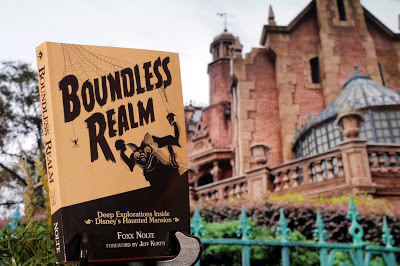
In September 2014, I lost my job.
While sitting outside wondering what I was going to do next, a stray thought occurred to me: maybe I should finally write that book. If only I had known...!
For some time before that, the idea had been percolating in my mind that I probably could write a book about the Haunted Mansion that would be unlike the other two books already written. Write what you know, as the saying goes, and I definitely knew the Haunted Mansion. Some time before I had read Roy Blount Jr.'s Hail, Hail, Euphoria!, a sort of text-based audio commentary for the Marx Brothers comedy Duck Soup, which moves along through the film point by point while allowing time to stop discuss matters requiring more elaboration. That struck me as an interesting way to structure a book about a theme park attraction. So I started writing one day.
The trouble is that I had no idea how to write a book except that I needed to write a lot, so I just kind of started writing. And writing. And writing. This is a terrible way to write a book, I probably don't need to say, but it was the only way I could think of to force myself through it. And one reason the book took as long as it did is because I very much invented what the thing was about as I deleted sections, added others, re-thought the format, and slowly discovered what the tone and shape of my first book was going to be.
Along the way the book stopped being wholly a 'virtual tour' of the attraction and began to widen out beyond the typical scope of a Disney book. On this blog I’ve often struggled to give full expression to the scope of my interests, but in this book they roam free, wide, and loose, causing frequent detours into history, or film culture, less exhalted corners of theme park design, or dreams and folklore. Each chapter in the book is, like the essays on this site, roughly self contained, but unlike here they can also build and twist back into each other since they are laid ut in a fixed linear way. So, if you just jump in and want read my thoughts on one section of the ride, that works as a contained unit, but as the book goes on the resonances between sections build into a more holistic portrait of a great piece of art. If you’ve ever wondered what a 300 page Passport to Dreams post would be like, here is your answer.
Yet I’ve also tried to keep the book fast moving and fun, and the result is, I believe, the first Disney book of its type published anywhere. This is the first critical monograph on an attraction ever published, attacking the question of what makes the Haunted Mansion so great from any angle I can find. Like it says on the cover: deep explorations.
And that's my best answer to why we need a third book on the Mansion. It really digs into why and how the thing works so well, and why this weird ride from 50 years ago still garners fans.
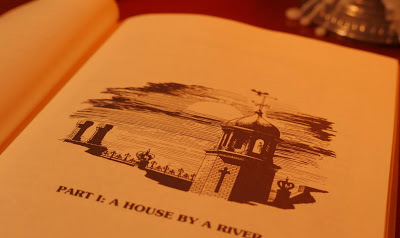
Look and Design
Those who enjoy the level of fiddly detail I poured into my previous giant project, Another Musical Souvenir of Walt Disney World, will find much that is familiar here. I wanted to make this book as intensely involved with the Mansion as I am, and I’ve made sure that every inch of this book is full of little touches that speak to its pedigree - like me - of a result of this intense involvement.
For instance, the illustrations. There were from the start certain things that I could not publish - either because I could never secure the proper clearances to do so, or because good photographs simply not existing. So I ended up rendering around 30 illustrations, which are almost as moody and detailed as the ride itself is.
I wanted the book itself to feel almost as if it’s inhabiting the same universe as the ride, not just lifting design cues. It would have been easy to throw the Haunted Mansion font everywhere and call it a day, but my goal here was to have an end result that felt as if you had gotten out of your doombuggy and pulled a book off the shelf in the ride’s library scene and it just happened to be this book.
I also wanted this book to be the sort of thing you would feel comfortable reading in the bath tub (where I do a lot of my reading) or popping in your luggage to take to Disney. I want you to enjoy and use this book, which is why it’s a reasonable size and only available in soft cover. As a twelve year old I dragged that huge Imagineering hardcover book with me everywhere, and it sure looks like it today. As a Disney book collector, I've also been encumbered with such volumes as the Taschen Walt Disney Film Archives, a thing of beauty that cannot reasonably be stored on existing book shelves. My book is intentionally the opposite of the monster eight pound books we have all been accumulating with increasing regularity.
There will be a digital version available, although only for Amazon's Kindle format. There are unfortunate technical reasons for this, as it became quickly apparent that targeting the more broadly supported EPUB format would involve essentially redoing all of the months of work we had just put into the print version. The Kindle version has all of the same content in a roughly comparable format, but the layout and text choices are compromised and in my opinion the book looks significantly worse. This is par for the course for eBook formats, so if you have the option, I hope you'll spring for the print version.
The title was a constant problem. My preferred original title was Sympathetic Vibrations, but there's already plenty of things out there already called that. For a long time I called the book This Old Dark House, which is what the central "tour section" of the book is called. I liked this because it made reference to the "old dark house" thriller genre which I feel the Mansion is directly descended from, but it's a sort of dopey thing to call a book. I knew I needed something better, something that ideally implied that the book had a certain historical perspective and was unusual. I landed on American Phantasmagoria, which I liked a lot. In the end, the name Boundless Realm occurred to me earlier this year, which is just about perfect. It's a line from the ride - although not an obvious one - and it implies the there's going to be a lot of ground to cover here. In concert with a cover image which intentionally leans more into "40s horror movie" territory, it really implies that this is going to be a Disney book with a difference.
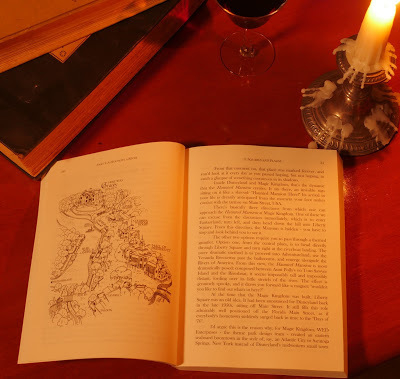
Delays and Delays
Some of the delays occurred as a result of simply needing to wait for Disney to finish things. I had written a chapter on Phantom Manor, actually one of my favorite sections in the book, when Disney announced they were going to close that ride for a huge refurbishment which they then kept extending. I wanted to wait to see what they did, which ended up being the right choice because the changes they made really ended up affecting the content of my chapter, which had to be revised.
And then so much time had passed that it didn't make any sense to not just wait for Chris Merritt's monster Marc Davis book, just to double check that his research didn't flatly contradict any of mine, which thankfully it did not. I had a manuscript, illustrations, a cover.... ready to rock and roll, right?
Except! It turns out actually getting anything published is another nightmare!
After slamming into this brick wall for a few months, my preferred publisher returned the opinion that a combination of the worldwide pandemic and the Disney connection meant they would not be pursuing this. I began talking to other authors about their experiences, and found that besides official publications and of course Theme Park Press, nearly every Disney book is self-published. Maning every author out there had been also turned down by multiple publishers.
If nobody else had yet succeeded, I figured my chances of breaking through were limited. That was a rough month for me, but I began to explore my other options.
I ended up partnering with David Younger, whose massive, ludicrous tome Theme Park Design is in my opinion one of the best books on the subject ever produced. Together, we've decided to launch Boundless Realm as the first in a hopefully ongoing series of high quality, scholarly books on aspects of theme park design less as a publishing house and more as a kind of collective effort of authors. This book would literally not have been possible without David's help and I could not be prouder of it.
David is also selling a bundle copy of his textbook and my book through his website, if you'd like to grab them together.
Boundless Realm is the culmination of a pattern which has been building in my life since I was five and went to Disney for the first time. That pattern continued through getting on the internet for the first time, building early websites, moving to Florida, starting this blog, and writing, and writing, and writing. The resulting book is handsome, very readable, erudite, and very, very me - exactly as I hoped. You could say it's the end product of three decades of living with a passion.
The Haunted Mansion has been a golden thread that has wound through the pattern off my life through up and downs but has never stopped bringing me joy and pleasure. For you, that thread may be Splash Mountain, or Indiana Jones Adventure, or The Beast at King's Island, but I think everyone will recognize the passion in this passion project. It's just surreal to finally see it out there in the world. I hope you love it as much as I do.
Reviews for Boundless Realm:
Guy Selga at Touring Plans (Review Copy)
Josh Young at Theme Park University (Review Copy)
George Taylor at Imaginerding.com (Review Copy)
Jeremy Harris on Matterhorn Matt
Boundless Realm is available at:
Amazon: Print and Kindle Editions
Amazon Canada: Print and Kindle
Amazon UK: Print Edition
Barnes and Noble: Print Edition
Bookshop.Org: Print Edition
Thank you for all of my readers over the years for your support!
August 21, 2020
Harold's Lost World of Snow
"It will be going the same speed it always has, but it will seem faster." - John Hench, Disneyland Line, December 1977
In 2003, I took my first trip to Disneyland, and Disneyland is one of those places that rewires the way you think. Besides absolutely taking my head off and stuffing it back on in a new way thanks to their incredible Pirates of the Caribbean - still my favorite ride ever - I discovered one of the great loves of my life: the Matterhorn Bobsleds.
I've spent a long time thinking about the Matterhorn, and a long time riding it, and it's one of those rides where I find my ardor for the experience cannot be contained by a logically structured essay. I suspect many folks are the same way about certain things: they can't say why they like it so much, but they do. I probably have never loved a roller coaster more than I love the Matterhorn, which says a lot about my priorities.
For one, comfort isn't one of them. The Matterhorn was rough in 2003, and after installing new bobsleds apparently made out of pottery and saran wrap in 2012, it got rougher. Those 70s Arrow Development sleds didn't seem to sit as low to the track and had better shock absorption, but the 2012 bobsleds are like a gigantic speaker pushing vibrations right up into your posterior. I haven't really cared; I've kept riding the thing, my feet pushed into the nose of the car, my hands gripping the handle bars, body tense and ready to absorb the pain.
I do it not because the Matterhorn is a great rollercoaster, or even because it's a landmark roller coaster. The Matterhorn, along with the 1975 Space Mountain, shakes you like a rag doll, which modern coaster enthusiasts absolutely do not like. They prefer their terror to come from drops and g forces, not being rocked around like a dead cat in a barrel being sent over Niagara Falls. As I said, I don't much care for roller coasters. I love the Matterhorn not at all because it's a coaster, but because it's an amazing experience, and there's only one of them in the world.
It's hard to say how much I would have liked the 1959 Matterhorn, with its hollow interior. What can be said is that the decision to enclose a roller coaster inside of an artificial mountain is one of those Walt Disney ideas which has become so ubiquitous in our culture that it is almost impossible to imagine a world where it does not exist. I'm fairly certain Walt got the idea from the Rutschebanen at Tivoli, a sort of scenic railway that dashes in and out of a scenic alpine mountain (with a fake cow in a field on top!). But as usual at Disneyland, the scale of the effort and the decision to combine it with a world famous peak made all the difference. The Matterhorn turned the idea of a fiberglass mountain into a genre, and Space Mountain would make it into an institution.
There is also just something about the other-worldlyness of the Matterhorn that works in some impossible to articulate way. The way it rises up and hooks with the little shadow just under its peak added by Fred Joerger - the way it hangs there against the hazy California sky, seemingly always further away than it really is. You can walk all the way around it, something you cannot do with any other stateside Disney mountain. That fact, and its central location, transforms the Matterhorn into something that exists for the pleasure of everyone, even those who do not ride. This is landmark design for pleasure, and it's been repeated endlessly since - I'm certain that the size and dreamy unreality of the Matterhorn is the basis for the height and effect of Cinderella Castle in Florida, for instance.
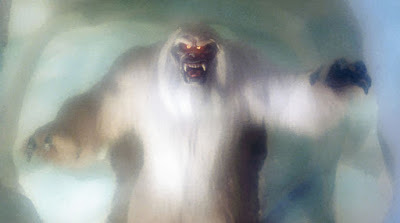
And yet all of that is literally just on the surface, what was put there in 1959. What I really love is the 1978 version, which in my opinion is an absolute stone classic in how to perfectly structure a themed experience, and do it so simply it's almost subliminal.
Storytelling in three dimensions is hard, and even harder because it rarely needs to conform to dramatic beats. Instead it could be said that most successful rides need to introduce a dramatic situation directly involving riders, then build and riff on that situation in a variety of interesting ways. Riding bobsleds down a fake mountain is pretty interesting already, but the wrinkle of introducing a rampaging monster really pushes the Matterhorn over the top. The idea supposedly goes back to Walt Disney, but how easily it could have turned out wrong.
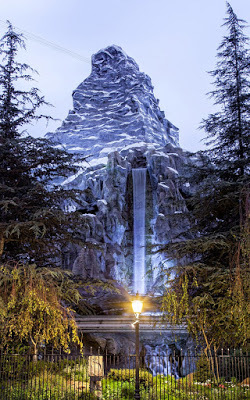 Lets begin on the approach to the Matterhorn from the Hub. As we draw near, there is a surprise: the trees part, and a huge waterfall comes into view. The waterfall instantly suggests that there is going to be more going on in the Matterhorn than we expect, yet the Matterhorn looks picturesque, inviting with its alpine trees and flowers. A mountain stream winds around the base of the mountain, which somehow looks like cold mountain water thanks to the contrasting landscape around it.
Lets begin on the approach to the Matterhorn from the Hub. As we draw near, there is a surprise: the trees part, and a huge waterfall comes into view. The waterfall instantly suggests that there is going to be more going on in the Matterhorn than we expect, yet the Matterhorn looks picturesque, inviting with its alpine trees and flowers. A mountain stream winds around the base of the mountain, which somehow looks like cold mountain water thanks to the contrasting landscape around it.Yet thats not quite the whole story. The whole top of the mountain is open, effectively turning its upper echelons into a gigantic loudspeaker which bellows out the unearthly roars of its resident monster. Even less comforting is the whistling wind which can be heard everywhere around it. This is the introduction of the dramatic conflict of the ride; the Matterhorn looks peaceful, welcoming, and charming, but.....
For my money no other theme park deployment of this concept comes even close to the raw elemental energy of this juxtaposition - the Matterhorn looks welcoming and inviting while also warning you to stay away. In the 70s, WED did a lot of this sort of stuff, and perhaps the wolf howl that emenates from the Florida Haunted Mansion and the booming cannons which once heralded the facade of Pirates of the Caribbean are predecessors. But those were really just atmosphere, whereas the approach to the Matterhorn initiates the dramatic conflict which will inform your entire experience: what's gotten into the Matterhorn?
The 1978 Matterhorn operated on the principle of suspense, and so the dramatic thrust of the story (will I escape?) mapped perfectly onto the build and release inherent in all coasters. This was an experience where the physical sensations of being on a coaster really meant something. The slow approach, the cheerful yodeling music, the wait at the bottom of the mountain ready to be released into the pitch black interior all built up anticipation. Of course all rides create anticipation, but the cheerful gemutlicheit of the Alpine landscape had an edge to it thanks to those unearthly roars.
The fact that the ride was going to be scary was announced instantly by the lift hill's perpetual gloom. The long monster roars were interspersed with screaming sounds, supplied by a speaker. The suspense of the lift hill is briefly released once the bobsleds peak and slowly begin to head downhill, then replaced with another kind of suspense. One of the best Disney jump scares of all time - the glowing eyes in the dark - illuminate with a ferocious roar, and now the rest of the ride is a long downhill slide where you are never entirely sure where the Snowman will be next. I've been on the Matterhorn probably a hundred times and I still sometimes forget exactly where the second Harold is.
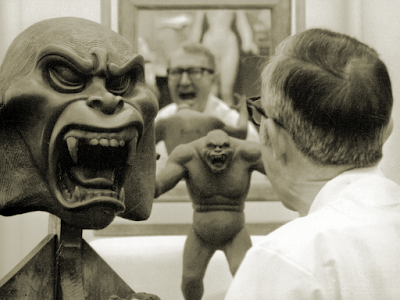
Harold is one of the best designed theme park monsters of all time. The original design is a perfect distillation of a monster; long white hair offsets his blue face and hands, defining a fierce looking body shape as a silhouette, instantly comprehensible as a threat. Long hair above the eyes de-emphasizes the forehead, making the creature seem less human. Two thirds of the face is an open mouth full of teeth, the white teeth highlighted against the dark scream of a face. The nose is tiny, almost invisible, and the eyes are asymmetrical, making the yeti seem fantastical, an appropriate resident of Fantasyland. Harold was literally reaching hands, a mouth full of teeth, glowing red eyes, and almost nothing else.
But the thing is, nothing else was needed . Under the best circumstances you could get maybe 5 seconds to look at him, and those key elements: mouth , red eyes, reaching hand read perfectly from a speeding bobsled. As Ken Andersen told the E Ticket in 1993:
"You didn't need a lot of animation because you were moving. You were moving so darn fast that what you did was supply the movement for the characters."That was the brilliance of Harold: he hardly moved, but he looked and felt alive. The long downhill escape, as well as his sudden reappearance, caused riders to fill in with their imaginations far more than was really going on. More than any mountain-dwelling monster who has suceeded him, Harold really felt like he was chasing you, popping through secret caves and dashing down rock wall faces in an effort to cut you off. The physical structure of the ride itself worked perfectly to put you off the wrong foot; was that roar coming from ahead of or behind me?
The Matterhorn was a long build of suspense, followed by a chase down to the bottom, the splash of the glacial pond the release of the tension. Compared to the Matterhorn, Big Thunder was one damn thing after another and Space Mountain was just weirdness, but the Matterhorn felt like real peril, and it was peril created with some light-up eyes and three figures that moved only just enough to create a sense of motion. It was, in its own way, brilliant.
I didn't really start to understand just how good the Matterhorn was until Expedition Everest opened at Animal Kingdom a few years later. I admit that the Matterhorn created in me false expectations of a suspenseful, "boo" kind of experience, which Everest really isn't. Beautifully mounted, the attraction doesn't introduce its dramatic conflict until over a minute into a three minute ride. It's nearly another minute until we see the shadow of the Yeti, who honestly seems more interested in tearing up railroad tracks than chasing riders, and there's a final confrontation mere seconds before the ride ends. But the real thing that I couldn't believe when I rode Everest in previews, the thing I walked off the ride saying, is that the multi-million dollar yeti was gone by so fast you could barely register that he moved at all. Fusty old Harold inside the Matterhorn gave just about as good of a show at a fraction of the cost, and his mountain had actual caverns inside it!
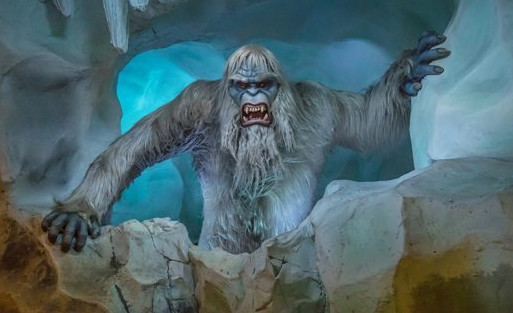
For my money, Disneyland's new Snowman figure has the same issue. He looks terrifically fierce, and he snarls and lunges at the cars, but the pure, streamlined, communicative power of that goofy 1978 figure has been lost. The new figure has a visible forehead, which makes him look a bit more human, and his mouth opens and closes, a detail often lost because you're by him way too fast. He seems almost realistic, and to me this makes the new Snowman less visually appealing, less like an appropriate resident of Fantasyland.
But really the biggest issue is that those reaching hands are gone. The new Snowman is grabbing the ice wall around him like he's climbing out of a cave, but that image of him reaching for the cars was really important. Look at the silhouettes; there's no comparison.

The new guy seems like less of a threat; when you pass him a second time, he's twisted around to the side as if he isn't even expecting you to come upon him. He's louder, and he looks meaner, but its harder to feel like he's really and truly out to get you.
The trouble is that the window of comprehension for understanding something you coast by in a bobsled can be measured in micro-seconds, and the new Snowman just doesn't cut it. Blaine Gibson had fully absorbed this fact of theme park life and was a master at sculpting figures just the correct side of impossible to read in a flash. Think of all the figures in Pirates of the Caribbean, sculpted in mid-smile or mid-scowl. Think of the Hitch-hiking Ghosts, with their hugely exaggerated extended thumbs.
Think of how much artistic skill it takes to correctly draw attention to something as small as a thumb.
Blaine sculpted Harold's scowling face in a permanent scream for a reason, and he gave him huge reaching hands for a reason, and grossly exaggerated their size so you couldn't miss them. That version of the Matterhorn's monster was fit for the job.
On a similar track, the same team in 2015 removed the ice crystal scene and replaced it with a new hoard of destroyed Matterhorn ride vehicles, like bobsleds and skyway buckets. The previous ice cavern scene was nothing amazing, but you could look over and see the crystals and hear the music and instantly understand that you were looking at some crystals. The new scene just looks like some random stuff, and you're past it before you can figure it out. Worse, nobody going into the Matterhorn fresh in 2020 (2021?) is going to understand what they're looking at, making it a weird in-joke that doesn't really look like anything. That's a shame, because most of the Matterhorn is spent looking at snowy rocks, and anything to make it feel a bit more like a real place was a help. Like the Snowman figure upgrade, it was a great idea on paper, but in practice is a misfire.
 From This 2014 Video
From This 2014 VideoBut the change that really stings me is moving your initial encounter with the Snowman to the lift hill. This makes some sense, but those glowing eyes were truly a perfect jump scare, and set the tone for the rest of the downhill chase. The slow ascent up the mountain in the pitch darkness listening to the wind howling built up terrific suspense, increased by the fact that Disney pumped in occasional scream sound effects to this scene. Was it another rider on the coaster, or was it....?
Then, the lift hill crested, and the first few moments of the ride were gentle. You relaxed. Then Harold's eyes lit up in the darkness and scared the tar out of you. I screamed on my first ride. And then you spent the rest of the ride on edge, expecting Harold to come bounding out at you again at every turn. That was the moment the ride had been building towards since you first laid eyes on it with its beautiful flowers, glistening waterfall, and baleful whistling wind.
I'm sure new riders enjoy the Matterhorn plenty, and I'm not here to make some absurd claim like Imagineering "ruined the ride". It's still lots of fun. But the previous version changed the way I look at theme park rides because of how much it was able to do with so little. That 1978 refurbishment, when you get right down to it, was a lot of rock work, three figures that only barely moved, some sound effects, and light-up eyes on a stick. But they totally transformed the tone and feeling of the Matterhorn, and gave it unique shape and rhythm. And they did it without changing the track.
And that's what the Matterhorn became for me, a kind of yardstick I use to measure all other rides: did the designers get the absolute maximum out of what they chose to build? I find this useful because it de-emphasizes the tech and the design density that Disney and Universal tend to get caught up in and looks simply at effect. Does what they spent money on really work?
The Matterhorn brought Harold to life with the simplest means, and did so in a way that was straightforward, understandable without words or preshow videos, and easy to maintain. The new version is flashier, but in sacrifing that elemental sinplicity of what was done in 1978, it is in my opinion significantly less powerful.
Because that's something that maybe gets lost in discussing the Matterhorn; it is one of the great scary Disney rides. Harold was designed to startle jaded 70s teenagers - who may otherwise have brought their business to a place like Magic Mountain - and did so in a way that was not so intense you couldn't still bring a six year old on the ride. Harold has moved out now, and try as I may, I've never quite warmed up to the new guy. The Matterhorn I fell in love with at 18 is now another resident of Yesterland, and I miss it dearly. That hollow wind still blows in my heart.
--
While I have your attention!
I thought I'd take some time to answer a few questions I've been getting recently about this site and to explain what the future holds for it.
I should probably begin with some context: this site, and text-based blogs generally, are enjoying a fraction of their old readership.
Time was, I could spend 2 weeks writing and editing a post that would reach an audience of over 20,000 people. Today, my posts are averaging about 2,500 people and capping out at around 7,000 on the high end. And the fact is, I haven't met a single person under the age of 25 who is a self-professed retro theme park fan who learned about them reading sites like this. They've learned everything they know on YouTube. It's fair to say that the time of the informational blog seems to have passed.
Which is why I wrote a book. That book is one reason I began posting shorter form pieces (like music loops) in 2015. The past few years have been weird for this blog, and this year has been a desert. This is because I've been seriously perusing getting the thing published since last November and the complexities of doing that have taken up all of the spare time I used to devote to writing blogs.
The good news is that the book is coming out this year; my next post will be its announcement! The bad news is that given the time commitment of writing blog posts vs the work that goes into writing a book, it makes more sense to write more books. I've already begun work on my second book, and now that I have a publisher, I hope to get it done in 2-3 years instead of 5 years this time.
This site has seen a spike in readership since the pandemic began, and its been wonderful seeing old readers and new coming back to enjoy my writing. I never wrote a word on this site for money or fame, and I have no intention of stopping writing. I actually have about four unfinished pieces right now that have been either delayed by work on my book or other issues.
So basically: more content is coming! I thank everyone who has stuck it out with me or has just recently discovered my stuff. It is amazing to me what this little writing exercise has turned into, and I want to keep it going as long as possible.
So till next time: stay cool, my friends.
April 30, 2020
Haunted Mansion Video Treasures
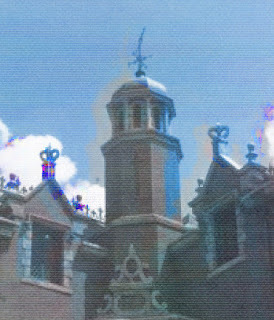 To this author, perhaps the greatest boon to my life afforded by the modern internet is video streaming - the ability to watch nearly anything at any time for reasonable cost in decent quality. And although I remain an enthusiastic supporter of physical media, the internet has become a digital Aladdin's cave of delights for fans of the weird and obscure. Writing this during the Coronoavirus shutdown, I've recently gone for strolls around Disneyland and Disneyland Paris from the comfort of my home thanks to the modern wonder of streaming high-definition video. And this, in a lifetime where I remember leaving my computer on for an entire week attempting to download Sam Raimi's first horror film through a telephone line.
To this author, perhaps the greatest boon to my life afforded by the modern internet is video streaming - the ability to watch nearly anything at any time for reasonable cost in decent quality. And although I remain an enthusiastic supporter of physical media, the internet has become a digital Aladdin's cave of delights for fans of the weird and obscure. Writing this during the Coronoavirus shutdown, I've recently gone for strolls around Disneyland and Disneyland Paris from the comfort of my home thanks to the modern wonder of streaming high-definition video. And this, in a lifetime where I remember leaving my computer on for an entire week attempting to download Sam Raimi's first horror film through a telephone line.I picked up the habit of mass video accumulation early. Around 1995 I became obsessed with taping things off television, and I still have a box of around 50 VHS tapes from Disney Channel and other sources that I've never been able to part with. A few years later, I was involved with the Haunted Mansion fan community as it existed through mailing lists and Yahoo groups at the time, and one of our hobbies was trading tapes through the mail of various home video ride-throughs. Please remember that this was a time when RealVideo was just about the best online video streaming option, and you still had to pay for the wonders of QuickTime video. Creating and mailing video cassette tapes was the more convenient option!
Well, I held onto those videos for a long time. A few years back, my good friend Michael Crawford helped me get a few of my stranger video treasures transferred, but I still knew there were goodies yet to be discovered. Late last year, I bought a new old stock VCR. It took several weeks of experimenting, but I'm finally getting results I'm happy with from my capture setup. And so here now are a few of the better tidbits that obsolete technology has granted me an archive of!
First up is a video of extreme importance to me and of nearly no importance to anyone else - just how we like them on Passport to Dreams! Along with Discovery Channel's Fun House documentary, this is probably what kicked my Haunted Mansion fanaticism into overdrive and turned me into the theme park person that I am today. It's a short excerpt from a show called Walt Disney World Inside Out, which Disney Channel ran weekly through 1996 and 1997.
Hosted by J.D. Roth (from GamePro TV!) and Brianne Leary (from CHiPS!), it was essentially part of the promotional mission surrounding the resort's 25th anniversary. Certain highlight sections ran between Disney Channel programming as "Inside Out Spotlite" segments, and this was the most memorable.
For context, you must realize that as a child my ability to see anything from the interior of the Haunted Mansion was limited to a few photos in a souvenir hardcover book and the Day at the Magic Kingdom VHS tape. So seeing a program that not only gave me a good look inside a personal obsession, but went further and explained how certain effects were done, absolutely floored 11-year-old me. I don't think I had even considered at that point that the ride was made up of illusions with secrets behind them, so seeing J.D. Roth put his hand through that bust rewired my brain.
From a historical perspective, this is the only good look I've ever found at the remarkable film bin looping devices invented by Ub Iwerks for WED in 1954. He actually engineered these things as part of his assignment to create Cir-car-rama for Disneyland, allowing the film to circulate endlessly through a giant series of spools without ever getting out of synch with each other. These same looping projectors were also used in the Main Street Cinema, using prints purchased from the Blackhawk Films library. The Haunted Mansion's 16mm 1-minute bins are cool enough, but the 70mm 15 minute bin loops for the Hall of Presidents were things of beauty, 25 feet tall. I wish I had thought to take a few pictures of them before the show switched over to digital in 2008.
This segment is also just quality Disney programming, perfectly judged to increase your appreciation of just how complex these attractions are without revealing too many secrets. Walt Disney World Inside Out was a show wildly variable in quality - there's episodes where they do nothing but poke around The Disney Institute - but when it's good like this clip, it can be very memorable.
Moving swiftly on, let's take in some vintage ridethroughs! These sorts of videos used to be easier to find online before YouTube became the dominant source for streaming video it is, but the migration to that platforms meant that a lot of older material simply never made the leap. Who remembers going to Visions Fantastic and downloading Disneyland videos?
These three vintage ridethroughs are amongst the best that I know of, but they actually aren't mine! These were on one of the tapes I traded for in the early 00s, and I've forgotten exactly who sent this one to me. As a result I've cut out the hitch-hiking ghost mirror segments of each video, because they weren't taken by me. For their vintage they really are excellent, shot with a higher end camera than most consumers ever had access to by a rider who really knew where each little detail was.
First up, the Magic Kingdom Haunted Mansion in glorious, low-fi murky regular vision! This is the category of video that is the toughest sell today, when we all have video camera on our phones that handle dark environments much better than this. But there's still value in this, and this is by far the clearest pre-2007 Mansion video I know of. Certain areas, like the first third of the ride, are near total losses but other areas like the Corridor of Doors are nearly exactly how they looked in real life.
It's also the best view I have of what the controversial "windblown" bride looked like in real life. Flash photos always made her look dopey, and as the years went on and more and more of her lighting and wind machines broke and were never replaced, she looked worse and worse. But when she was brand new she at least was impressive, and that is captured well here.
Some stray observations before we move on. First, the line. For the past fifteen years, Walt Disney World has been so busy and so plagued with the scourge known as Fastpass that it seems almost incomprehensible to look back at a time when except on the very busiest days you could walk on Haunted Mansion with a very modest wait. There were no interactive queues and other such nonsense things to get in your way; once you got through the turnstiles at the porte cohere, that little corner of the park with the family cemetery butting up against the front door was as serene as an actual graveyard.
Second, take note of the entrance area. This particular arrangement - with the front gate that had been put in the early 90s, plus the hearse and fountain which had replaced a large planter and tree in 1997 - ended up lasting a mere 2.5 years. In 2001, Disney put up the Fastpass building which clutters up the area today, added a covered-over fountain smack in the middle of the walkway, and took down the central gates with the dead wreaths on them which much better communicated the idea of "old, closed-off estate". The intersection of strollers, Fastpass building, former Keelboat dock, and gate in this area has been a logistical disaster for at least the quarter-century, and I really wish the park would tear the whole area out and rework it.
Let's take a moment to enjoy the "Aging Man" effect in its full original form here, and actually facing the proper direction! The 2007 digital morph, although certainly smoother, has never struck me as being as eerie or oeneric as the original effect here is, with simple fades between each stage in the deterioration. This is almost certainly a device built in 1969 for use in the Disneyland show, back when they were planning on a full 6 stage transformation for each of the portraits. It was crated up and shipped to Florida instead, and I wish I had thought to take a picture of it before it went digital in 2007.
As for the direction of the portrait, it's been wrong since then. The projector is aimed at the ceiling; it bounces off a mirror and onto the scrim, meaning it's reversed twice once you view it from the other side in the Foyer. Whoever composited the video flipped it to account for the scrim but didn't know about the mirror. That's another small touch I hope they fix when they upgrade the projection to HD.
Before real low-light video cameras became a thing, the most coveted form of ride video was night vision, in which your camcorder spit out a beam of infrared light. In retrospect, it's bizarre that home camcorders even had this option, given that it makes people look like weird glowing demons. However it was amazing for theme park nerds who wanted to take in every detail of their favorite rides, so let's take another spin through, this time, in phosphorescent green!
We begin with a decent look at the Load Area in its mostly original state; I believe the lights along the loading belt went blue in the early 90s and that the red and white wallpaper replaced an earlier pattern sometime around that time. In the 1997 refurb a couple of theatrical lights were dropped in through the ceiling around the corner, pointed down to illuminate the pinch point where the line becomes single file; just a few years later, wall sconces would be added to properly illuminate the floor space. At the same time, weird elevated urns on shelves would be installed to disguise speakers for the safety boarding announcements. Finally, in 2007, the "Sinister Eleven" portraits would migrate to the load area, the wallpaper would be replaced again, a "ledge" would be added to lower the apparent ceiling height, and a solid black wall separating the queue from the doom buggy track would be built.
Practically every old-school Florida Mansion fan was unusually fond of that table, chair and lamp on the other side of the buggies; it was a weird little tableau that suggested that perhaps an unseen ghost was doing a little late-night reading! All of those props are in the Attic now and although I'm not hardline enough to insist that their removal ruins the scene or anything, I do wish that WDI would add some stuff over in that corner because it did help the Mansion feel more like an actual house.
I'd also like to bring up the Corridor of Doors. Nearly the whole soundscape of the Mansion was re-mixed and re-jiggered in 2007, and largely I think they did a terrific job - although many of the changes are subtle, it's one reason I think the Florida Mansion feels very fresh and dynamic. And while many Mansion fans have bemoaned the loss of the original Graveyard vocal tracks, I think the removal of the original Corridor of Doors voices is just as big of a loss. Generally, the 07 sound mix veers heavily towards ominous rumbles and creepy whispers - the sort of thing that we recognize from horror films of this millennium. The 1969 Corridor of Doors tracks are definitely way closer to old fashioned haunted house album tracks if you sit down and listen to them individually, but they never played that way in person because you simply didn't have time to sit there and listen to each one. The new version of the scene is still creepy, but the original was way creepier.
So let's talk about the Attic scene. The pop-up guys up there always were a controversial feature of the ride, and I think at its heart the reason is because you had just come from the Ballroom, the spectacular visual highpoint of the ride, and around the corner was a skeleton dude bobbing up and down on a stick.
But, you know, they didn't have to suck. Were the figures properly hidden, and dropped down out of sight immediately, you wouldn't have to be stuck looking at a static head on a stick slowly being ratcheted out of sight. Making the situation even worse, in 1997 WDI decided to put glowing purple top hats on every one of them, meaning that even the ones properly hidden could be spotted thanks to their dumb glowing top hats.
Then there's the separate case of that first fellow on the right as you entered. I have no idea if he was simply malfunctioning for 8 years, but more often than not he looked the way you see in this video - way too far up, bouncing around in midair, looking stupid. When I was a little kid, this guy came out of an open trunk on the floor and scared the heck out of everyone. It still works that way in Tokyo Disneyland, the last place on earth to enjoy this simple effect. I have a suspicion that someone in Imagineering wanted the popups to be this way, to give "riders a hint" before they appeared.
But the thing is, the only positive thing you can say about a head on a stick that pops out to scare you is that it scared you ; with the exception of rubber spiders bouncing around in webs earlier in the ride, it's the crudest thing in the Haunted Mansion. I miss these guys, but I don't miss the way you see them in this video, looking stupid and not properly hidden. If you're going to have a jump scare, you need to commit to having a jump scare, and I think without at least one or two in the attraction, the Haunted Mansion is missing something. The Attic is supposed to be the dark heart of the ride, the room you were never supposed to see, and on that count Connie doesn't cut it.
And, oh, hey, the graveyard of my teenage years! The Singing Busts were out of synch. Somehow, after the switch to "laserdisc technology" as our ghostly friend George put it to J.D. Roth, they were never quite able to synch them up properly. Also, the Old Man was REALLY loud, and the mummy didn't have a vocal track. Was that way until 2007, as best I can tell. Also, if you listen REALLY carefully, you can barely hear the "La-da" singer track by the Hearse, still lurking around in the late 90s. This was a graveyard vocal removed from Disneyland for some reason and some folks are obsessed with it.
Alright, let's hop a plane over to California for one last bit of Mansion-y goodness.
Again, this was a short-lived incarnation of the Mansion. A 1995 refurbishment introduced changes to the Seance Room and Attic, as well as the red wallpaper in the stretch room (which I've always preferred) and an upgraded sound system. Many of these changes were subsequently removed by further changes in 2005, meaning it's increasingly difficult to find good versions of this incarnation of the ride.
The "I Do" version of the Attic has always struck me as a pretty good middle ground between keeping the popups and decreasing the intensity of the scene. Interestingly, in this version of the scene the popups rose one at a time, from the back of the scene to the front. I'm fairly certain that the first guy in the hatbox right by the entrance was supposed to come up every time another one did, but he appears to be broken on this day. Sadly, this pattern did make it possible to go thru the whole scene and not see a single popup. I know because I accomplished this feat more than once in 2003. Videos from the early 90s do show the pops all rising at once, as they did at Magic Kingdom, so perhaps starting in the 90s Imagineering began exploring ways of lowering the intensity of the Attic.
The two other notable changes occur nearer the start of the ride. Imagineering has imported the "Leota tilty table" effect designed for Phantom Manor, which I've never liked all that much. It's fine in Phantom Manor because there isn't much else going on it that room, which I'm fairly sure has a smaller diameter circle around Leota anyhow. I think the "flying Leota" used at Disneyland and Magic Kingdom is a much better upgrade to the scene.
The other change is the reintroduction of some Ghost Host dialogue in the Corridor of Doors. Supposedly the attraction opened with this in 1969 and it was removed a few months later, perhaps as part of the same refurbishment which saw them move the bride and deal with cellar flooding. I've never liked these lines, and was sort of afraid they would introduce them to Magic Kingdom in 2007 as part of that refurbishment. However, I can see how they help keep the Ghost Host more of a participant in the attraction during Disneyland's shorter ride, because without them he gets you on the ride, commands you to listen, then leaves a minute later!
Also, I like and miss that "Dead End!" sign outside the Unload area.
When we talk about Disneyland and Magic Kingdom, especially on sites like these, it can be so fun to dig into the history and details of the places that we forget that they're constantly changing, in ways big and small. Time races by regardless, and now that the mere look of analog video is nostalgic, I hope these small documents of a time long since past are helpful or at least fun. Everyone stay healthy and let's hope for a return trip through the Mansion soon!
--
Looking for more spooky fun? Head on over to our Haunted Mansion Hub Page, or check out this index of articles on Walt Disney World History!
November 22, 2019
Dead Media from Tokyo Disneyland
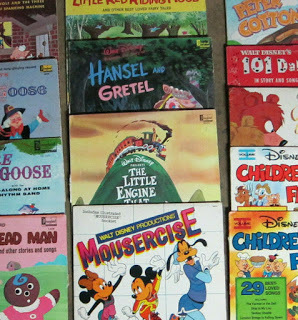 Once, a long time ago, listening to music at home meant buying records. And, in those days, Disney records were in a league of their own. The Disneyland record label consistently made something that was viewed as a banal part of everyday life fun and interesting with elaborate gatefolds, slipcovers, and lavish multi-page books. Disney's key target demographic was children - cheap plastic record players had become increasingly common through the 1960s, and "storyteller" records with included storybooks were a good way to keep children entertained. Releases such as Country Bear Jamboree and The Enchanted Tiki Room are fascinating objects for modern theme park fans because of this lavish attention to detail.
Once, a long time ago, listening to music at home meant buying records. And, in those days, Disney records were in a league of their own. The Disneyland record label consistently made something that was viewed as a banal part of everyday life fun and interesting with elaborate gatefolds, slipcovers, and lavish multi-page books. Disney's key target demographic was children - cheap plastic record players had become increasingly common through the 1960s, and "storyteller" records with included storybooks were a good way to keep children entertained. Releases such as Country Bear Jamboree and The Enchanted Tiki Room are fascinating objects for modern theme park fans because of this lavish attention to detail.Sadly, by the late 70s and early 80s, buying a Disney album on LP had become just about the worst way possible to experience the product. Long gone were the lavish booklets and clever custom programs and the quality of the records - which had never been all that hot to begin with - had degraded to near paper-thin. Late-stage landmark Disneyland Records releases such as The Official Album of EPCOT Center and, yes, Mickey Mouse Disco and Mousercise are just lousy products - thin-sounding, with cheap packaging. It's a fairly depressing state of affairs for collectors who enjoy these items as mementos, even if the actual contents of the discs are rarely exactly earth-shaking.
But there is an exception, and I recently discovered it: the LP release of the Official Album of Tokyo Disneyland. It's weird, and lavish, and surprisingly interesting.
To begin with, the booklet is back. Except this time it's something more akin to the "Pictorial Souvenirs" produced for stateside parks in those days, making it a pleasant complement to the other early Tokyo Disneyland souvenir products, such as their guide maps and souvenir picture book.
We've covered Disney's exceptional photographic publicity from this era before, and interestingly Tokyo Disneyland got the royal treatment in 1982 and 83 - even photographs which could have been duplicated from identical areas at Magic Kingdom, such as inside It's A Small World, got brand new excellent photography.
Best of all, the center of the LP booklet is a reproduction of the park's 1983 map poster, the one where the spot that would one day be occupied by Star Tours has the Queen of Heart's soldiers "painting the roses red". These delightful vintage items are among the most expensive on the second-hand market, so having a medium-size reproduction here is a real treat.
Go ahead, pop it on the turntable and give it a listen.
The contents of the LP are fairly interesting as well. The nearest analogue is the 1980 "Official Soundtrack of Disneyland/Walt Disney World", but in comparison that release was frankly a budget affair - dropping together various tracks from already-released albums in basically random order. But in terms of arrangement and sequencing, the TDL effort vastly exceeds it.
For instance, the 1980 DL/WDW release has a few tracks that paste together some of the more popular shows, such as Country Bear Jamboree and Hall of Presidents. These are clearly cut down from the existing mix-down versions done for lavish LPs released in 1972, giving the tracks a rushed, inelegant sound.
In comparison, the TDL equivalents of these tracks are actually mixed from isolated source elements, possibly because the music elements were available having been utilized in creating the new Japanese language soundtracks. The new versions are much better, and give us opportunities to hear things not heard in any other version of these soundtrack releases - the piano introduction to Teddi Barra's number in Country Bear Jamboree presented without Henry's narration being a high point.
The entire first side of the album is dedicated to Fantasyland. Walt Disney Productions was very concerned that Japanese audiences would not connect with the other areas of the park, which is why the Americana aspects of the park are de-emphasized - renaming Frontierland to Westernland, for instance. But Japan HAD been a clearing house for Western animation and cartoons through the 50s and 60s, and the emphasis on their cartoon back catalogue here both reflects Disney's strategy in Japan and sets the stage for the cartoon mania which still grips that park.
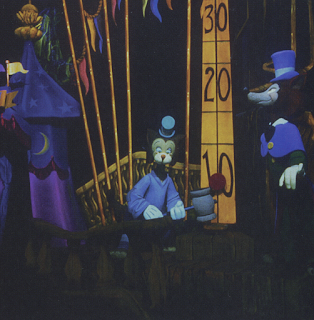 The extra space allows the Disney sound engineers to do some interesting things. Background and incidental music is featured, something that would never happen on Western releases until the 21st century. The version of Mickey Mouse Revue finishes with a cut-down version of the attraction's theater entrance music, ending with funky guitar riffs which nearly scream 1971. Elsewhere, attraction underscore is presented for Peter Pan's Flight and It's A Small World.
The extra space allows the Disney sound engineers to do some interesting things. Background and incidental music is featured, something that would never happen on Western releases until the 21st century. The version of Mickey Mouse Revue finishes with a cut-down version of the attraction's theater entrance music, ending with funky guitar riffs which nearly scream 1971. Elsewhere, attraction underscore is presented for Peter Pan's Flight and It's A Small World.The crown jewel is Pinocchio's Daring Journey, which was heavily marketed within Japan as being designed exclusively for Tokyo Disneyland (it wasn't, and managed to remain exclusive to Tokyo Disneyland for about three months, but theme parks could get away with things like that in 1983). Practically a quarter of the first side of the platter is devoted to this ride, with a mix of what I believe is attraction underscore and Famntasyland area music. It's bizarre to listen to this record as elaborate mega-attractions like Pirates of the Caribbean blip by in one-minute sound clips while Pinocchio's Daring Journey goes on... and on... and on. The soundtrack on this record is longer than the actual attraction is.
Side Two continues with excellent Japanese-language compressions of Tiki Room and Country Bear Jamboree and is highlighted with a short version of Meet the World. The Tokyo Disneyland record is not only the best park soundtrack of its era in both technical and presentation areas, but also paves the way towards the modern Disneyland soundtrack.
But before I had the record, I had the cassette.
Purchased in a bulk lot of Tokyo Disneyland items, I picked up the cassette on a whim because I was intrigued that it was devoted entirely to Fantasyland - before I knew that it represented Side A of the LP release. But I was fascinated by the oddities of its tracks, especially the Daring Journey track, and was intrigued enough to import the LP from Japan to continue the search. Here, in the interest of completion, is the cassette version of the Fantasyland tracks.
I'd still like to know how this was released. There's no indication of it being, say, Cassette 1 of 2, and it appeared in my life all alone, in its own vintage plastic case with no insert. A compact cassette can hold much more music than an LP can, so if Disney simply wanted to issue the TDL soundtrack on cassette, they were perfectly capable of doing so without splitting off the Fantasyland tracks over two sides. What I suspect is that this was released as part of some sort of book and tape combination, probably focusing on the Fantasyland area of the park, and the book has since gone missing.
It's an oddity, to be sure, but an oddity that crosses over through a lot of my interests - there can't be too many others who are invested in theme park music, vintage releases from Japan, write a historical blog such as this, and who have the equipment already sitting around to digitally transcode both records and cassette tapes of both.
It's a narrow window, sure, but even minor players like these in the history of how a park was promoted upon opening can be interesting, never mind the very first overseas Disney theme park, the first black ship launched into foreign waters. It's an auspicious moment that looks both backwards and forwards at the tail end of the Post-Walt era before Disney would rapidly become very, very different.
--
If you enjoy Disney Park obscurities and weird old music, then you're in the right place! Check out our Walt Disney World History Hub for more deep dives and Park Music Hub for more old music rescued from weird old formats!
May 10, 2019
Meet Beverly: The Italian Connection
Look online and you'll find plenty of colorful adjectives to describe it: the worst taste in the world, like old socks, like puke.
But there's more to the stuff than that! And with the Coke exhibit likely ready to be torn down in the next couple of years, let's take a quick tour of what Beverly actually is, learn some history about it, and perhaps gain some perspective on what is actually a fairly interesting little beverage that's been making hapless American tourists gag for 20 years.
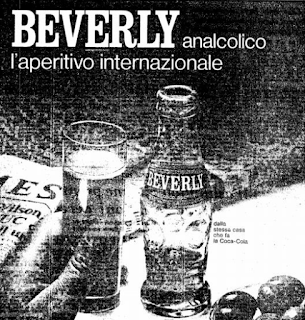 Italy, Meet Beverly
Italy, Meet BeverlyBeverly is an aperitif drink, which is a tradition essentially unknown in the United States but beloved in northern Italy.
You almost certainly have come across forms of the aperitif recently in the United States, with the bitter Italian subcategory of drinks lately being very vougeish among drinkers. The most infamous is currently the Negroni. As author Mark Kingwell memorably noted, the Negroni is not a drink for fence-sitters - it's strong, bitter, and thick, and those who love it love it precisely because it's overkill.
If you're allergic to bitter flavors and all you've had in the way of experience is Beverly and perhaps a sip of Negroni you're going to be tempted to write the whole thing off right now... but wait. There is an aperitif for every palette.
Perhaps more fundamental to the concept of the aperitif is the ubiquitous Italian vermouth, a mild red wine spiced up with various botanicals. Poured into a tall glass over ice, it's as basic and Italian as an aperitif gets, and a gentle start to an evening of leisure.
But the thing is, I can't really convey what an aperitif is in toto by pointing out examples, because simply an aperitif isn't a single product so much as it is a whole range of practices - a whole way of thinking about things that went down in flames in the United States with the death of the cocktail hour. And while elaborate drinking rituals have returned in city centers over the past two decades, as Americans we still don't have an instituted culture of stopping the work day with a lightly alcoholic, sparkling drink as a prelude to dinner.
That's really what can't be conveyed here, in this country where we have trouble keeping work out of the rest of life and cannot stand any dickering around over matters such as stopping to enjoy a casual drink and snack at the cusp of the evening. But it's a very civilized way to start the evening, if you're so inclined to give it a try - and the options available to you are numerous.
There are as many apertif beverages as there are towns in Italy, and they cover the entire range from sweet and welcoming to minty and medicinal. The most common options are Aperol, Cynar, Ramazzotti, Campari, Montenegro, and Averna, but there are hundreds. The other thing to understand is the most common way of taking these beverages is to top them up with sparkling water or prosecco, which utter transforms them. Bitter Campari, which taken straight from the bottle will remind many Americans of cough syrup, lightens up into a surprisingly sweet, round drink redolent of blood oranges when lengthened with seltzer. It is therefore appropriate to think of these bottled mixers as being comparable to the concentrated syrup that Coca-Cola is made from - tough to drink on its own, but add carbonated water and the flavors open up dramatically. Pre-diluted bottles of the most popular options, such as Campari, are sold throughout Italy for easy imbibing.
Which brings us back to Coca-Cola.
Coke introduced Beverly in Italy in 1970 in an effort to hedge their way into the popular regional drinking traditions. Advertised as "Cold as Helsinki - Sparkling as Rio - Dry as El Paso", advertisements of the day show a non-alcoholic, deep red (!) beverage alongside newspapers and revelers. And if you were a gigantic corporation trying to establish a toehold in an international market that had remained stubbornly loyal to traditional local beverages, what would you do to sway drinkers to try your new product? You'd probably model it as closely as possible on the most popular aperitif on the market, wouldn't you?
The flavor profile Coke chose to emulate was Montenegro, among the lightest and sweetest of the amari on the market. Montenegro is among the most approachable options on the market, herbal and sweet straight out of the bottle rather than harsh or minty as many are - the Montenegro American website suggests such options as a "Monte Mule", "Monte Manhattan" or "Montenegroni" for home mixographers. But to an American Epcot fan, all it takes is one sip and you'll immediately know - this tastes like Beverly. Actually - this tastes better than Beverly.
Around 2007, I began to become interested in getting ahold of the real bottled Beverly, but could find nobody who could import it for me. According to the World of Coke website, Beverly was discontinued in 2009.... if it was widely available at all by then. Traditional amari won... at least in Italy.
World, Meet Beverly
Coke and Disney have always had a traditional partnership, but it wasn't until the 80s when the company laid down sponsorship money for The American Adventure at EPCOT Center that Coke really solidified their hold on Disney - a position they have yet to cede. Ahead of the opening of Animal Kingdom, Coke negotiated a new deal with Disney for a series of drink stands across the resort, which resulted in some of the tackiest features of Walt Disney World's absolutely most garish period. Animal Kingdom got off easy, with the beautifully realized Dwolla drink bar in Asia. Of the rest, the least egregious was the expansion of the Refreshment Outpost in World Showcase's "Africa" section into the Refreshment COOLpost. Disney-MGM Studios got this terrible freestanding oversized 6-pack of Coke:
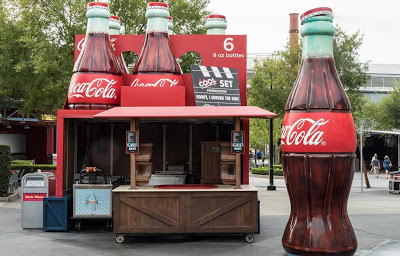
Instead of the Hot Set, this was the COOL set, and the lid of the giant bottle would pop open and spray passersby with water. I still can't believe this survived for two decades.
Magic Kingdom's Tomorrowland stand, the COOL Ship, at least somewhat fits in with the rest of the area, although why we are still subjected to stacked shipping boxes of cola is the definition of suspect theming. Perhaps the stacked futuristic shipping boxes of Coke were a necessary counterbalance to the stacked futuristic shipping boxes of Fed-Ex which once littered the open floor space in the Space Mountain queue?
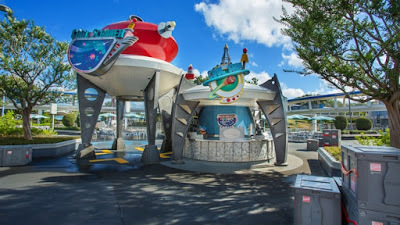 This is the official photo, look how proud they are.
This is the official photo, look how proud they are.But poor Future World got the worst of it, starting with the Test Track COOL Wash, where blinking lights inform us "Frozen When Flashing!". Mist and fans spray water out in all directions, car wash bristles reveal the shape of cola bottles when spinning, and a Test Track car in the center of it all has the last remaining crash test dummy. Here it is in 2007 with its original Test Track colors:
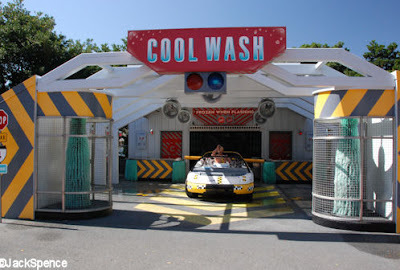 Mr. Iger, tear down this car wash!
Mr. Iger, tear down this car wash!But somehow none of that was quite as bad as a giant igloo in the middle of Epcot, emblazoned with the pink text "Ice Station Cool".
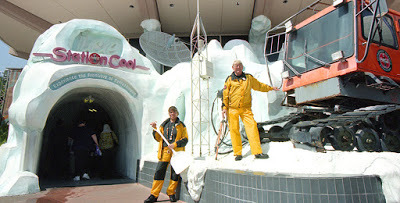
Opening in July 1998, Ice Station Cool at least was the most elaborate of these experiences, offering a short tunnel where the temperature was kept near freezing thanks to a pair of air curtains and a show machine regularly produced snow drifts. This emptied into a shop themed after an arctic exploration base stocked with Coke t-shirts. The drinks were dispensed by these strange contraptions aimed a gigantic globe on the rear wall of the shop.
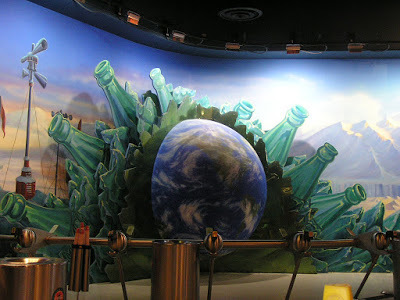
The most memorable aspect of Ice Station Cool was the frozen caveman glimpsed halfway through the cold tunnel, of course captured in ice at the moment of his demise clutching a bottle of Coke. Personally, as a frequent visitor to Epcot in 2004 and 2005, the most memorable aspect was the raised rubber treads on the floor, which were perpetually sticky with spilled soda. By that time the air curtains had been turned down and the snow machine would simply dribble some cold water on your head. But perhaps, in the end, truly the most noteworthy thing about Ice Station Cool his that it unleashed Beverly on an unsuspecting population.
In 2005, Ice Station Cool was closed and reworked into Club Cool, the form that it exists in today. This basic installation was copied and brought back to the World of Coke attraction in Atlanta, where it is known as the "Taste It!" exhibit. The original flavors were Krest Ginger Ale, Fanta Kolita, Beverly, Vegeta Beta, Kinley Lemon, Lift Apple, Smart Watermelon, and Mezzo Mix.
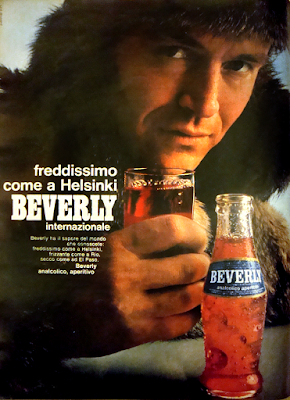 As you have probably realized by now, I have remained a fan of Beverly since I began to become accustomed to bitter flavors in my 20s, and more than once repeated shots of Beverly have saved me from dehydration after a full lap around World Showcase on a summer day. I've been the subject of intended pranks to "tricking" me into drinking it, which I have always done and reported my enjoyment. To me, the bitter taste of Beverly is as much a part of Epcot as Spaceship Earth.
As you have probably realized by now, I have remained a fan of Beverly since I began to become accustomed to bitter flavors in my 20s, and more than once repeated shots of Beverly have saved me from dehydration after a full lap around World Showcase on a summer day. I've been the subject of intended pranks to "tricking" me into drinking it, which I have always done and reported my enjoyment. To me, the bitter taste of Beverly is as much a part of Epcot as Spaceship Earth.What I'm not convinced of, however, is that what Coke is distributing there is actually a fair representation of Beverly.
In the research dives for this article I've only ever come across very old Italian advertising for Beverly, which to me suggests that even before Coke officially pulled the plug on the stuff in 2009 it was effectively off the market anyway. What Beverly tasted like in Italy in the 70s we'll never know, but I'm not convinced that the Epcot version is an accurate version. For one, it's not red, which we know for sure the product was on launch. Additionally, it's much, much bitter-er than Montenegro, which it's transparently modeled on. Third, it's being distributed for free in a theme park by the division of the company that never produced it. I think Coke is offering a fairly crude approximation of Beverly, that the real product in the 70s was likely much better balanced, and of course the pure volume of the stuff being mixed with carbonated tap water and dispensed into tiny paper cups all but ensures that the flavor will never be quite right.
But the fact is that even if the flavor was dead accurate, the context would always, always be wrong. Epcot tourists have certain in-built expectations when they see Coca-Cola, and something dry and bitter is not one of them. Additionally, placed right in a row of sweet flavors, the bitter, medicinal taste will always hit harder than if it were sampled, say, before the rest. Presented across a bar, in a tiny glass, and offered as something reminiscent of a Dry Martini, Beverly would have an opportunity to find an appreciative audience. But Coke knew very well what they were doing here, and they set up these tourists to gag and groan and spit and do all of the things they've been doing since July 1998.
Except some of us. Some of us who really like it.
We have no idea if the Coke exhibit is going to be relocated once Communicore gets torn down in a few years, and with Beverly off the market, what's a fan of bitter soda to do?
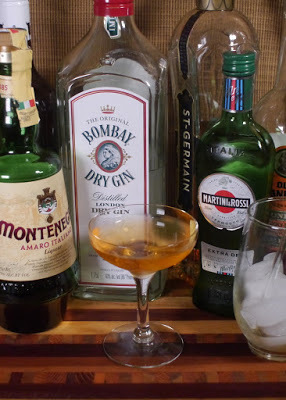 Home Bar, Meet Beverly
Home Bar, Meet BeverlyOnce I came across Montenegro and immediately recognized it as the basis for the taste of Beverly, I began excitedly experimenting. Perhaps it would be easy enough to simply dilute the stuff with seltzer and I could enjoy Beverly at home?
It wasn't that easy. Over my years of making Negronis at home, I've learned that amari react in strange and unusual ways to being tinkered with. As a syrupy mixer, they have a background taste that some of their least kind critics compare to cough syrup. Diluted, the sweetness becomes properly checked and the fruit flavors emerge. Stirred with other spirits, the bitterness comes forward and the syrupy quality remains. Shaken up with ice, the syrupy quality vanishes and a pleasant, surprising dryness emerges - one can easy make a Negroni into a dry, summery drink by shaking it up with and orange wedge, whereas the stirred version is a strong, brooding drink.
In this case, the Montenegro simply turned into orange soda once it was diluted with seltzer, far too sweet to hit those familiar Epcot Beverly notes. I would have to get creative.
In this case my blueprint was a spin on the Negroni called the Lucien Gaudin, which balances the aggressive Campari with triple sec, resulting in a surprisingly sophisticated cocktail. Again the gentle nature of Montenegro required careful handling and rebalancing.
The result is a beverage that tastes reminiscent of Beverly but with the edges sanded off. It's orangey-sweet and not too strong, which required a new name...
Velvet Beverly
1 tsp St. Germain Elderflower Liqueur
1/2 oz Dry Vermouth
3/4 oz Montenegro Amaro
1 oz Dry Gin
Stir until very cold and strain into a cocktail couple. Garnish with a fancy lemon peel.
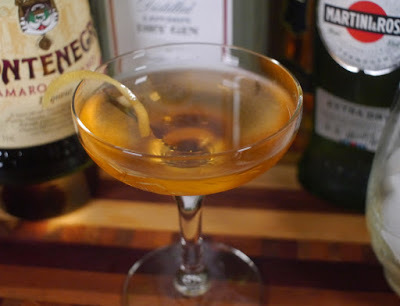
The Elderflower Liqueur can be substituted for Triple Sec, Maraschino or indeed any other cordial you enjoy. Go easy on the teaspoon - most of the sweet in the drink comes from the Montenegro, which should be kept in check.
Even those of you who prefer to keep things on the sweet side will perhaps next time stop by Club Cool and think of Beverly in a different way. When your palette becomes fatigued by the sugar, try a sip or two to cleanse your taste buds. Or pour yourself a cup while you're leaving and sip it as you stroll into World Showcase, as a refreshing and fortifying end to your sugar high.
It's a fascinating product, a failed attempt to emulate a fortified cordial invented in 1885 half a world away, then re-created to shock and surprise theme park tourists in Orlando. Even 20 years later it's a stranger to this land - dislocated, out of time - but sometimes it's the strange things I treasure the most. Ciao!
We have more entries on Walt Disney World drinks, real and invented:
Jungle Navigation Co. Punch | The Seven Seas Drink | Howling Dog Bend
April 11, 2019
Five Batshit Crazy Rides
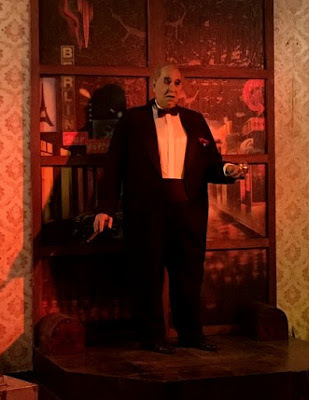 Okay everybody, put on your silly hats, because today we're all about really weird rides.
Okay everybody, put on your silly hats, because today we're all about really weird rides.As a Disney World-obsessed child growing up on the other side of the country, although Disney was a major influence on my interests, the fact is that it was not an everyday, every week, or even every-year thing. Just as big of an influence on me, in those multi-year stretches between the family vacations, were less-ambitious examples of theming: malls, miniature golf courses, oddball restaurants, and regional amusement parks. So while the obsession really took hold between the ages of eight and ten or so, the fact is that I have more, and stronger childhood memories of something like Lake Compounce or Riverside Park or Lake George than I do Walt Disney World.
On this blog, we spend a lot of time talking about the prime cuts: the Disneys and Universals of the world, which offer beautifully, fully realized environments. But just as compelling to me are the lesser steaks, the parks that operate on smaller budgets and milder ambitions, that make do with less. They may not be as rich and juicy, but there's a lot of flavor to chew on in places like Knobels, or The Enchanted Forest, or Silver Dollar City.
Which is maybe a longwinded way of saying: I love Pirates of the Caribbean, but I love the weird shit too, and there is simply not enough of it on this blog. And while these five examples may not per se be on the same level as a handmade mini golf course in Michigan, they aren't exactly on the Disney or Universal or Efteling level either. What they are is truly, truly bizarre, sometimes ambitious, fascinating, and, yes... batshit crazy.
Mammut Tree, Conny Land, Switzerland
We'll start with something fairly mild. As the park says, "to conquer this tree, you need nerves of steel"!
A landmark in Conny Land, the Mammut Tree looks like a gigantic redwood with its top blown off. On the ground level, pedestrians can walk around and through the root system of the tree. In the air, a cable car takes riders through a hole in its top. Looks harmless, right?
Except! when the car passes through the terrifying Mammut Tree, doors close around the car and it's trapped and, then... well maybe you should just watch the video, but there's wind, sparks, fireballs, and... yodeling.
Conny Land has other oddities, like a shuttle coaster that stops you upside down and a Universe of Energy-inflected dinosaur dark ride, but it's the weird, inexplicable "mammoth tree" that captures my heart. It's like a non-sequitir given physical form.
Gremlins Invasion, Warner Brothers Movie World, Germany
When I was about ten years old, Gremlins was one of my favorite things in the world. It's the perfect "starter" scary movie - crazy, a little gory if you're ten, suspenseful, and sweet. It's gone on to be recognized as something of a classic in years since, but in the depths of the 90s with the world having moved on all I could do is rent the thing and keep spreading the word and wondering if I was the only one who loved this movie as much as I did.
Suffice to say, had I had access to this attraction as a ten year old, Gremlins Invasion / The Great Gremlins Adventure would maybe be my favorite ride ever.
The premise begins with absolute lunacy and only gets weirder from there. Passing through a receptionist office and into a screening room at "Warner Brothers Studio", visitors are treated to a collection of bloopers from films past and present hosted by... Sandra Bullock? Okay...
After several minutes of this, we suddenly cut to the set of ALF, where ALF is chasing the household cat under a sink. He's then attacked by the Gremlins, who electrocute the cameraman shooting the television program. As ALF encourages viewers to flee, the projector breaks and the famous "film break" segment of Gremlins 2 plays. An employee rushes into the theater to hurry the audience to a load area where the ride operator has been killed by the Gremlins, but no worry - ALF and Gizmo are at the ride controls!
Some context here. There were two versions of this attraction, one in Australia and one in Germany. The Australia version featured Beetlejuice, which I suppose makes some sense as that character was then at the height of his popularity and was also a fourth-wall breaking, horror comedy kind of character. If you squint a little, you can see why somebody would make the connection.
Meanwhile, over in Germany, ALF had been something of a cultural phenomenon, and he took a much larger role in the German edition of the attraction, piloting the vehicles through the Warner Brothers Film Archive and appearing in the pre show. While touring a film archive under attack by Gremlins while Beetlejuice appears and cracks wise is plenty bizarre in itself, the inclusion of ALF as a major character elevates the simply weird into the truly sublime.
You wanna know what? This ride is pretty good. It uses entirely dimensional sets, it has decent gags, and it's perfect for the Gremlins - attacking a movie studio and re-enacting scenes from Singing in the Rain and The Adventures of Robin Hood. There's a decent Pepper's Ghost gag where ALF and Gizmo electrocute a number of Gremlins, and another moment where the ride vehicles pass each other and trailing behind the second vehicle is a ride car filled with Gremlins. The finale where ALF arrives in a fire truck has never made much sense, but if you've gotten this far into the ride, what do you honestly expect? The Gremlins pack themselves into boxes, the film archive burns, and the perfect late 80s pop culture dream state ends.
In the past ten years, Gremlins Invasion has graduated from obscurity to minor infamy due to the ever-vigilant novelty consuming nature of social media, but right there at the intersection of crazy and possibly good sits a ride starring Sandra Bullock and ALF that was torn down for a Van Helsing coaster. It is, in its' own small way, perfect.
Donkey's Sherry, Shima Spain Village, Japan
This one only exists thanks to the diligence of park designer Dave Cobb, who knew weird when he saw it back in the 90s. Donkey's Sherry is vastly bizarre and makes one wonder what other strange rides once existed across the globe that were never documented and since have been lost.
A fever dream starring anthropomorphic donkeys, rather than the cute Disney-style characters you may expect, this is entirely "musician of Bremen" style donkeys, upright animals wearing clothes. As the ride begins, the donkeys are manufacturing the sherry, crushing grapes in huge wooden vats, drinking the sherry, dancing in the town square, getting drunk.... and then things get weird.
The absolute masterstroke of Donkey's Sherry, if it can be said to have one, is after all of the escalating insanity with executioners, conquistadors, and a burning city, is the puzzling final scene, where we are left to wonder if the whole thing was the drunken hallucination of an animal. Honestly, we're left to wonder if it wasn't a drunken hallucination of *ourselves*, but no matter. there may be plenty of questionable in Donkey's Sherry, but find me another ride that wordlessly suggests a twist ending with nary a bit of narration.
Looney Tunes Adventure, Warner Brothers Movie World, Germany
Here I go picking on poor Movie World Germany again. For what it's worth, this park has a really interesting history which predates its Warner Brothers branding in the 90s, and Warner did a lot of interesting things with it when they bought it. It was the only place in the world with a rapids ride themed after The Never-ending Story, a stunt show based on Police Academy, and a Batman Returns motion simulator. It was.... very odd.
Much like Gremlins Invasion, Looney Tunes Adventure was a copy of a similar ride originally built at Movie World Gold Coast in Australia. In both attractions, we enter the Looney Tunes Studio where a pre-show room has an actor interacting with animated figures of the Looney Tunes characters. It seems we're just in time to participate in the filming of their newest picture, to be set in, depending on one's location, either the outback or the Black Forest of Bavaria. So off we go into the ride and board a boat...
Where even to begin? The animatronics were designed by Sally Corporation, and honestly with the exception of Bugs, who's very difficult to translate into three dimensions, I think they're pretty good. But mein gott, this ride is just strange. The juxtaposition of the Looney Tunes, faithfully realized in three dimensions, with realistically created trees, rocks, and Bavarian architecture is just strange. But what pushes the whole thing from peculiar to haunting is the fact that there is absolutely no musical soundtrack during the ride! The Looney Tunes act out their comedy at the sluggish pace provided by mid-range animatronics circa 1996, viewed from a slow moving boat, and scored to a backdrop of birdsong and croaking frogs. The result is queerly suspenseful, but strangely compelling, in a mirror-world kind of way.
Oh, and another thing. I gave a simplified version of the actual story in the description above, because it was already confusing enough that their was a somewhat similar but also very different Looney Tunes Adventure in Australia. In the pre-show, you see, we're welcomed to "Hollywood" (the sign is on the mural in the background) and told that Bugs Bunny has gone to Germany to scout new film locations! In order to make the film, we must, and I kid you not, dig a hole through the earth to Germany . Speedy Gonzales asks if he can get good tacos in Germany, and no, I didn't just make that up. So we're led to the set of an old Science Fiction film, where Marvin the Martian is at the controls, and we ride his gigantic drill, Flight to the Moon style with televisions and a shaking floor, to the Black Forest. This is why Bugs says "Welcome to Germany!" when we see him in the first scene.
So at the Looney Tunes Adventure at Movie World Germany, we're transported to Hollywood for a pre-show, then through back immediately to Germany in the most bizarre way possible. Here's a video with both of the pre-show rooms, and a better view of the baby dragon encountered at the finale:
What can I say? It's strange, very strange, and I wish like hell I could have seen it. I'm sure the same kid who would ride El Rio del Tiempo six times and who grew up to write this blog would have loved every strange moment of it.
(Thanks very much to this blog post and this wiki article for helping make sense of blurry videos in other languages!)
Hollywood Tour, Phantasialand, Germany
I don't know what it is about Germany that just breeds crazy rides, but I'm well aware that 4 of the 5 on this list are located in Germany or Switzerland - and I didn't even get into Europa Park! This is also the only true knockoff on this list, but boy howdy, it's a dilly.
Phantasialand is honestly a very well realized park, with compelling rides and far, far above average textures and theming. One simply has to look at the facade and queue of their enclosed drop tower, Mystery Castle, to see that they're working at a much higher level than their competitors. Their version of Main Street is a lushly realized vision of Berlin at the height of its pre-WWI spendor. They have a very interesting Chinese variation of the Haunted Mansion, one of the most inspired such "reinterpretations" in the world. Oh, and there's Hollywood Tour, which is honestly insane.
To get on this ride you climb up! up! up! many staircases until you reach a barely decorated loading room where an animatronic of a director holding a martini - who may or may not be Alfred Hitchcock - addresses you. Then you board a boat, drop into a cavern, and...
The type of internet commentator who likes to shriek that any less than perfectly realistic animatronic is "creepy" will have a field day here, but really, those are the cheap shots. This ride is almost perversely strange, and the low budget figures are just part of it. It's the whole thing, the strange music, the slow pace of the boats, the reckless and entirely bizarre idea to replicate a mashup of the Great Movie Ride and the Universal Studios Tram Tour as an animatronic boat ride...
I love, for instance, that it recreates the Jaws scene at the Tram Tour in bizarrely specific detail - including the now-removed fishing guy in a boat who's pulled underwater. The entrance from The Great Movie Ride is there, as is Wizard of Oz, but in other cases they're riffing and coming up with their own weird versions of iconic scenes, like Frankenstein or an unspecified giant spider movie. The whole thing builds up to an experience that's appropriately named... it's oneiric, half remembered, hallucinated.
It's a mutt, but I love mutt rides - after all, the Disney and Universal park franchises now have options all over the world, but there's only one Hollywood Dream.
What's your favorite batshit crazy ride from outside the world of the billion-dollar attractions? Leave the details in the comments, and if you enjoy reading about Theme Park design, check out our archives here. Thanks for reading!
January 25, 2019
Caribbean Plaza: The Sound of the Sun
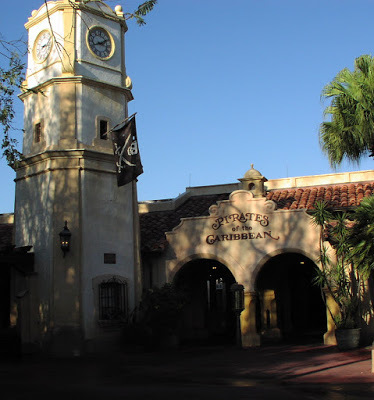 (It's BGM catch-up month here at Passport to Dreams, with two shorter posts this month to get a record of the remaining fully identified original loops online!)
(It's BGM catch-up month here at Passport to Dreams, with two shorter posts this month to get a record of the remaining fully identified original loops online!)Caribbean Plaza had its signature attraction, Pirates of the Caribbean, ready in December 1973 but didn't really mostly come online until April 1974, when all of its shops and snack bar were operational. At some point in that few-month period, a new piece of BGM arrived.
And so from December 1973 until July 3, 2006, Caribbean Plaza echoed with steel drums. Although highly atmospheric, much of the steel drum music begins to sound the same after enough time, and for years it was thought that the same steel drum music had been playing in the Plaza since it opened.
Thankfully a few years ago Mike Lee came forward with a 1991 live recording of Caribbean Plaza, which he identified as the music he had heard playing in the Plaza when he was a child. Since many of the original 70s BGM pieces survived until the early 90s, this was entirely credible as the original Caribbean Plaza loop.
Interestingly, it turned out to be merely the first 9 of 12 tracks of a single vintage album, played entirely in album order. Given our educated guess back in 2013 that the original Main Street BGM was simply one album played entirely in album order, this definitely fit an established pattern.
Caribbean Plaza Area Music (1973 - 1993)Running time: approx. 30:00
01. Sixty-Nine
02. Patsy
03. Coc-che-ohco
04. Erica
05. Landlord
06. Mamma, this is Ma's
07. Mambo Lake
08. Love in the Mist
09. Linstead Market
All tracks are sourced from the 1967 album Trinidad: The Sound of the Sun by the Westland Steel Band. Thanks to Michael Sweeney for identifying the tracks.
The Westland Steel Band LP has cycled through various owners over the years, and currently can be legally streamed through YouTube. I've created a playlist of the full Caribbean Plaza loop:
20 years later, Disney was modernizing Magic Kingdom's sound system and many old Jack Wagner loops, stored and delivered on magnetic tape, were being phased out and replaced with new ones as the new, CD-based delivery systems came online. Down the street, Adventureland Veranda's languid tropical strings were replaced with upbeat drumming from an endless loop of a single CD released by Balafon Marimba Ensemble. When Caribbean Plaza got its CD player, WDI imported a track from the then-new Disneyland Paris.
Caribbean Plaza Area Music (1993 - 2006)Running time: approx. 60:00
01. Fire Down Below [3]
02. Grass Skirt [3]
03. Trinidad Girl [4]
04. Mary Ann [3]
05. Spear Dance [3]
06. Grenadine Jump-Up [1]
07. Zulu Chant [3]
08. Badjan Mambo [1]
09. La Paloma [3]
10. Soca Batiste [Edited: 00:00 - ~05:39] [2]
11. Jungle [3]
12. Calypso Non-Stop [Edited: 00:00 - ~07:00] [2]
13. Native Mambo [3]
14. Beef Island Merengue [1]
15. Spur Dance [Edited] [3]
[1] Bomba!: Monitor Presents Music of the Caribbean by Various Artists (Monitor Records, MFS 355)
[2] Steel Band: Antigua & Trinidad by Various Artists (PlayaSound)
[3] Steel Band Music of the Caribbean by Various Artists (Legacy International)
[4] Steel Bands Carnival by Various Artists (PlayaSound)
Notes: Playlist based on 2009 live recording of El Pirata y el Perico by Horizons and compiled by wedroy1923 with assistance from eyore, Filmographik, and needmagic.
One of the goals of the area music conversion in the 90s was to get more music playing in more places of the park, and to get more consistency across the musical signatures of the various areas. As a result the new loop played in areas which previously did not have music, such as the snack stand complex across from Pirates of the Caribbean. This allowed the 1993 loop to survive the area's switch to Pirates of the Caribbean movie music in July 2006 and be recorded and documented in 2009.
Speaking of the Pirates franchise movie score BGM, the history of that version is an interesting story in of itself. While it overtook the steel drumming in 2006, it's gone through multiple versions and locations over the years.
While the hour-long length of the thing strongly suggests it was created for Magic Kingdom from the start, the movie score music was actually used at Disneyland in the attraction's foyer area, displacing the iconic Pirate's Overture for at least a few weeks before being removed. The movie score music actually stuck at Magic Kingdom, where it very soon began to feel at home amongst the sun-washed plaster walls. The original version of the loop was retired in 2007 when the score for the third film, At World's End, was made available, replacing several redundant cues and greatly improving the variety of the loop.
El Pirata Y El Perico was given a mild facelift in 2011 and re-christened "Tortuga Tavern", at which time the 1993 steel drum loop was removed and replaced with a new loop of nautical and ocean-going music. Interestingly, as of Summer 2018 this Tortuga Tavern music now appears to play in the main corridor of Caribbean Plaza, with the movie score being relegated to the extended queue outside of the attraction.
I'm sure kids born in the early 2000s will one day be nostalgic for the Jack Sparrow music, which did indeed lend a sleepy area of Magic Kingdom a certain gravitas. My nostalgic preference is for the sound of the steel drumming music, but there's honestly nothing inherently wrong with any of these choices; what should the 16th-century Caribbean "sound" like anyway?
Miss the original Pirates of the Caribbean? Take a listen to my restored soundtrack of the 70s version here.
Want more theme park music? Check out the Passport to Dreams Park Music Hub!
DEAR READERS: Starting in 2019, Passport to Dreams will be going off its monthly update routine, to focus on providing more of the long-form writing this site excels at as well as clear time for larger projects that need to get finished. If you'd like to get updated on when new posts arrive, please follow us on Facebook or Twitter. Thanks for your support!
January 17, 2019
Musically Setting the Stage
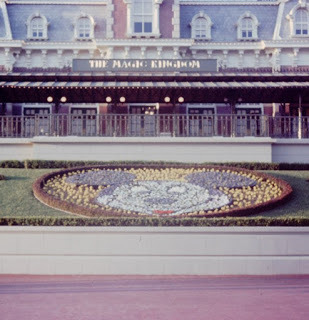 (It's BGM catch-up month here at Passport to Dreams, with two shorter posts this month to get a record of the remaining fully identified original loops online!)
(It's BGM catch-up month here at Passport to Dreams, with two shorter posts this month to get a record of the remaining fully identified original loops online!)The Main Entrance music at Disneyland and Magic Kingdom is one of those few that average people get pretty emotional over. Specialist news websites report when it has been changed, and a quick search shows these pieces of music are among the most frequently reposted on sites like Tumblr and YouTube. There's just something about it.
What is that exactly? Is it the upbeat orchestrations? The sweeping feeling? Or is it simply the act of being there, hearing the music again?
But if you stop and think for a moment, there's absolutely no hard and fast rule that Disney was absolutely going to play upbeat Disney music just outside its gates - in fact, there was no rules about the music that was going to be played at all. And yet many of the choices made by Jack Wagner back in 1971 and 1972 have remained fairly consistent as various versions of in-park music have come and gone, and the Main Entrance music hasn't ever strayed too far from that original musical template. So let's take a look at those early entrance loops.
Two versions of them circulate through collector's circles, a short version and a long version. In most cases, I would be inclined to believe that the short version is simply an incomplete recording of the long version, as is the case with several shorter versions of the Skyway Music in circulation. But in this case the track order of each is significantly different.
Also, the run time of the short version is about 44 minutes, and as we have already established on this site, most of the really early Magic Kingdom loops run about as long. Therefore, in the lack of other compelling evidence, I'm inclined to treat this shorter version of the Main Entrance music as the original version, which was later padded out to one hour in the mid-70s when other loops such as Main Street and Frontierland were also altered.
And oh yes, since we're talking about Walt Disney World here, it's worth remembering that this music played at both the Transportation and Ticket Center and the Magic Kingdom.
Transportation and Ticket Center / Magic Kingdom Turnstiles
Short Version, (1972 - 1975)
01. Me Ol'Bamboo [3]
02. Mickey Mouse Club March [4]
03. Whistle While You Work / Heigh Ho [4]
04. Pop! Goes the Weasel [4]
05. Parade of the Wooden Soliders [4]
06. Step in Time [6]
07. Supercalifragilisticexpialidocious [6]
08. The Work Song [6]
09. Who's Afraid of the Big Bad Wolf? [8]
10. Winnie the Pooh (Songs from Winnie the Pooh) [8]
11. The Wonderful Thing About Tiggers (Songs from Winnine the Pooh) [8]
12. Colonel Hathi's March [2]
13. The Bare Necessities [2]
14. Disney Medley No. 1 [2]
15. Disney Medley No. 2 [2]
16. March of the Cards [2]
17. it's a small world [2]
18. When You Wish Upon a Star [1]
19. A Marching Band (We're the Mouseketeers) [8]
20. A Wonderful Day Like Today [2]
21. A Dream is a Wish Your Heart Makes [6]
22. Roses of Success [3]
23. Trotter's Mile [3]
24. it's a small world (Choral Version) [5]
25. Zip-a-dee-doo-dah [1]
26. Chim Chim Cher-ee [1]
27. Supercalifragilisticexpialidocious [Mary Poppins Medley] [8]
We know for sure this has to have been installed in 1972 because the WDW Band record wasn't available until then. And then, here's the version that played until it was replaced by the Disneyland Paris main entrance music in late 1991:
Transportation and Ticket Center / Magic Kingdom Turnstiles
(1975 - 1991)
01. Mickey Mouse Club March [4]
02. Whistle While You Work / Heigh Ho [4]
03. Parade of the Wooden Soldiers [4]
04. Supercalifragilisticexpialidocious (Mary Poppins Medley) [8]
05. Winnie the Pooh (Songs from Winnie the Pooh) [8]
06. Wonderful Thing About Tiggers (Songs from Winnie the Pooh) [8]
07. Disney Medley No. 1 [2]
08. March of the Cards [2]
09. it's a small world [2]
10. When You Wish Upon a Star [1]
11. it's a small world (Choral Version) [5]
12. Zip-a-dee-doo-dah [1]
13. Chim Chim Cher-ee [1]
14. Supercalifragilisticexpialidocious (Mary Poppins Medley) [8]
15. Me Ol'Bamboo [3]
16. Mickey Mouse Club March [4]
17. Pop! Goes the Weasel [4]
18. Step in Time [6]
19. Supercalifragilisticexpialidocious [6]
20. The Work Song [6]
21. Who's Afraid of the Big Bad Wolf? [8]
22. Winnie the Pooh (Songs from Winnie the Pooh) [8]
23. Colonel Hathi's March [2]
24. Bare Necessities [2]
25. Disney Medley No. 1 [2]
26. Disney Medley No. 2 [2]
27. A Marching Band (We're the Mouseketeers) [8]
28. A Wonderful Day Like Today [2]
29. A Dream is a Wish Your Heart Makes [6]
30. When You Wish Upon a Star [1]
31. Trotter's Mile [3]
32. Hip Hip Pooh-ray! (Songs from Winnie the Pooh) [8]
33. Little Wooden Head [7]
34. Zip-a-dee-doo-dah [1]
35. Keystone Cops [9]
[1] Academy Award Songs [Vol 1. and Vol. 2] by Frank Chacksfield and His Orchestra (Decca, 1969)[9] Capitol Hi Q Series Release 094 'Cartoon'
[2] Disneyland Band by Disneyland Band (Buena Vista Records, 1969)
[3] Fantasmagorical Themes from Chitty Chitty Bang Bang by Irwin Kostal and His Orchestra (United Artists Records, 1968)
[4] Hi-Fi Music for Children: From 2 to 92 by Russ Garcia and His Orchestra (Liberty, 1957)
[5] It's a Small World (Especially at Christmas) by Disneyland Boys Choir (Buena Vista Records)
[6] March Along with Mary Poppins by Members of the Famed U.C.L.A. Band (Disneyland, 1965)
[7] Pinocchio: Music from the Original Motion Picture Soundtrack (Disneyland, 1963)
[8] Walt Disney World Band by Walt Disney World Band (Buena Vista Records, 1972)
This longer loop, at least, also played outside of Disneyland's main entrance during the same era.
I feel like I haul this observation out every time we look at an old Jack Wagner loop, but isn't it delightful how absolutely odd this thing is? Jack seems to have begun with the Disneyland and Walt Disney World Band LPs as his basic sound, then branched out to Russ Garcia's extremely oddball Hi-Fi Music for Children and Irwin Kostal's Fantasmagorical Themes from Chitty Chitty Bang Bang.
I've recently discovered that many of today's Disney fans don't know about Chitty Chitty Bang Bang, but the capsule version is that it was a 1968 attempt to create a Disney-style movie launched by the creators of the James Bond franchise. They were through in their poaching of the talent that made Mary Poppins sing, including the Sherman Brothers, Irwin Kostal, and Dick van Dyke. The Disney Studio, which prized loyalty over all else (and still does), rankled at the insubordination represented by the Shermans' departure. So it's very amusing to see that music from that film used to play outside of Disneyland and Magic Kingdom - a modern equivalent might be if the soundtrack to Anastasia played somewhere at WDW.
EPCOT may have legendary entrance music, and the Studios parks have famous movie themes, but nothing quite replaces that emotional feeling of standing in front of the train station and hearing a beloved Disney song drifting on the breeze. Despite all of my hemming and hawing on this site over total musical obscurities, that it's that emotional connection that Disney really invented and perfected in the middle of the 20th century. It's things like this that are why we're here.
Want more theme park music? Check out the Passport to Dreams Park Music Hub!
DEAR READERS: Starting in 2019, Passport to Dreams will be going off its monthly update routine, to focus on providing more of the long-form writing this site excels at as well as clear time for larger projects that need to get finished. If you'd like to get updated directly when new posts arrive, please follow us on Facebook or Twitter. Thanks for your support!
November 23, 2018
Weird WDW: Eulogy For A Dancing Hippo
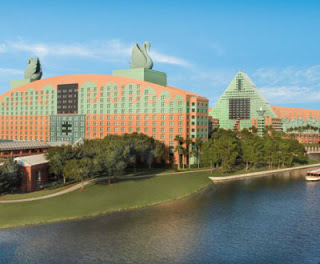 It doesn't feel like it anymore, but there's still a lot of weirdness left at Walt Disney World. The past ten years have seen a shocking amount of expansions, reboots, reconstructions and rejiggering, not all of which have sat well with fans. But travel outside of the well worn haunts to the distant corners of property and you will find remnants of the 90s and even 80s still hanging on, passive observers of a Disney nearly unrecognizable.
It doesn't feel like it anymore, but there's still a lot of weirdness left at Walt Disney World. The past ten years have seen a shocking amount of expansions, reboots, reconstructions and rejiggering, not all of which have sat well with fans. But travel outside of the well worn haunts to the distant corners of property and you will find remnants of the 90s and even 80s still hanging on, passive observers of a Disney nearly unrecognizable.One of these corners is Fantasia Gardens, a miniature golf course Disney built only after a long legal battle with the hotel entities that own the Swan and Dolphin. The Swan and Dolphin themselves were once emblematic of weird WDW, but they were redone in the 00s and again recently and their teal and salmon decor and rococo, trellesed madness has long since been subdued. But keep walking.
Out on the edge of nothing, backed into a corner by an onramp, is one of WDW's great forgotten corners - the Swan and Dolphin's picnic pavilions. While it seems that the nearby tennis courts were originally constructed in 1990 with the opening of the hotel complex, part of Disney's agreement with the operating partners for those hotels was that the space across the street was earmarked for any "entertainment complex". Five years and much gnashing of teeth later, Fantasia Gardens opened in 1995.
The Swan and Dolphin have always been more heavily favored by a certain class of business traveler than families, and so perhaps the idea of adding picnic pavilions to complement the full array of meeting facilities seemed a good one at the time. But I can think of no other area at Walt Disney World that has lived out such an abandoned, twilight existence as the "Sorcerer's Apprentice" and "Dancing Hippo" pavilions. At least River Country, Discovery Island, Wonders of Life and the ImageWorks were in use at one point in time; I don't think I've ever seen the picnic pavilions in actual frequent use.
Visited today, it's clear that cast members treat these pavilions as a backstage area, the event space strewn with chairs, burnt out light bulbs and intermittently in use fans. Between the two pavilions, in an antechamber that hasn't seen a simple dusting in many years, are two bathrooms, cleaned and stocked daily, for the patronage of nobody. There are areas of the Disney convention centers, especially the less popular ones like the Grand Floridian, where the bizarre disjunction between the effort to keep them maintained and the actual patronage feels as acute, but rarely as at Fantasia Gardens.
In college, when I was a rebellious Cast Member, I'd sometimes park at Fantasia Gardens and walk into Epcot the back way. I'd pull into the unmanned parking lot and wonder at those bulky warehouses on the other side of the pond, silent and empty. I'd visit the lobby of the Dolphin, stroll the Boardwalk, then enter Epcot and make the World Showcase loop. It was a pleasant afternoon, and each visit began and ended with the pavilions on the edge of forever, as dark and empty as they always were.
Disney is about to tear these down, and the Tennis Courts too. An expansion has been deemed necessary, and a small tower is being built on the former parking lot and tennis courts. The pavilions will become the new parking lot for Fantasia Gardens. By the time you read this, they may already have been dismantled.
In our current amped-up, plugged-in world of Disney fandom, consider that the closure of the garish Hanes T-shirt shop at the Village was deemed worthy of a minor round of complaining, and yet there are people who practically live at Walt Disney World but who have never even seen the Sorcerer's Apprentice and Dancing Hippo pavilions. They've been around for 23 years, meaning they lasted longer than many of the original EPCOT Center attractions, but they've entered life and are now leaving it as desolate and forgotten as ever.
Weird Walt Disney World is still out there for you, if you're willing to go find it.
Do you enjoy Walt Disney World History? Passport to Dreams has you covered with a full history resource full of facts, photos, video and more! Dive in!
Foxx Nolte's Blog
- Foxx Nolte's profile
- 17 followers



